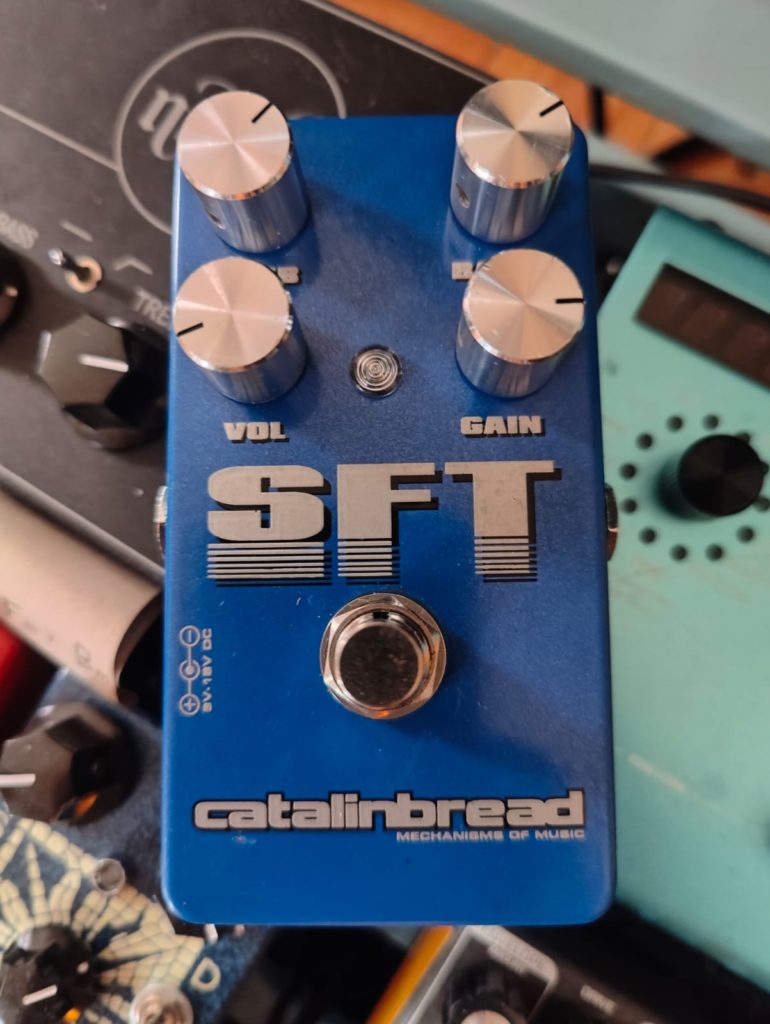Catalinbread SFT

This is a Catalinbread SFT, in the rare blue version that came between the first “Checkerboard” design and the “Fake Ampeg Logo” one. The internet was not entirely clear, but it seems these all run the same circuit and the changes were cosmetic, only the newer versions with the added switch are different, but I also read those newer ones are voiced a bit more towards guitar.
Looking up the manual, this pedal seems to mimic (vintage) ampeg. Not a specific ampeg amp, but rather following the topology of what ampeg did in general. It uses a two band Baxandall tone stack, and according to the manual, there are three gain stages – the EQ sits just before the last of them.
So you could consider it an amp in a box, an amp that ampeg could have built.
Hooking it up to my setup, I do expect to get copious amounts of beef, solid low mid growl and heft.
When someone says ampeg amp, I immediately think “SVT”. The fact that this pedal here is named “SFT” is not exactly dampening that expectation.
Ampeg did make guitar amps, too, though.
With the EQ not being entirely post drive, but two thirds in, it does affect the drive somewhat. I must admit that I love how that affects the treble knob. Prior to reading the manual, I did spend a solid amount of time with my headphones on and my eyes closed, trying to figure out how the treble knob is placed in the circuit. The bass knob feels like it sits pre drive, but the treble knob is quite magical. It seems to get the best of both worlds with this placement. When you turn it up, the treble increases overall, but also the amount of the driven highs increase slightly.
The bass knob is, in that regard, a slight disappointment for the expectations I formulated beforehand.
With the bass knob at noon, it’s about flat, or as flat as it will go. Turning it up will increase bass for the first few increments, but then it will only increase how hard the low end gets distorted.
At this moment, I realized that I did formulate some expectations on how this pedal should sound without any research, demos or any outside help – which is, plain and simple stupid.
I can’t take a look at a pedal and decide how it’ll sound and then be disappointed when it does not sound like that. To my defense – giving the pedal a three letter name where the first is an S and the last is a T and then designing it to look ampeg’ish is not the best idea when that pedal does not do SVT sounds.
However, I gave it a few days where I played other pedals, then revisited the SFT with the knowledge that this is … what it is – and not what I expected it to be – and the contact went a lot smoother the second time around.
The nature of the drive of the SFT reminds me a bit of a Sansamp. It gets a bit farty, like your cabinets are slowly giving out. There is, for my tastes, a clear sweet spot to be found. I tried different approaches, but all led me to the same settings. Gain just past noon, depending on the bass. This is the area where you get a solid grind, even when playing softer. Bass turned up some – as far as it’ll go before it increases the low end grit – so around 1 o’clock. Treble running rather high, about 3/4 up. There’s also a clear point where my ear tells me that that particular frequency range gets too much and starts overpowering neighboring frequencies. With those settings, there is a solid grind going on. I did, by pure chance, happen to find a bass in my house that was strung with Elixir rounds, not the freshest, but not old ones, either. Trying those, the drive gets me a metallic note that reminds me of Tim Commerford in the early RATM records. There are no shrieking, ear piercing highs available in the pedal. The top end sounds a little bit dampened – that’s good because there are no ear piercing highs, but that’s also bad, because there is a lack of that airy open feeling up top. This is not the drive pedal you use to put a little more character on your solo part, or to add some magical glow to chord picking high up the neck.
This is more down to earth, hands-on (and hands dirty). I can see this right at home in hard rock and maybe even stoner/sludge/doom, especially when you don’t want an overly bass heavy sound — but one that is a heavy sound nonetheless.
Audio Snippet: Playing a P bass with a pick. Treble maxed, Bass around 1 o’clock, Gain around noon.
Another snippet: Fingerstyle with the Treble around 3 o’clock, the Bass around 3 o’clock and Gain lowered to about 9 o’clock.